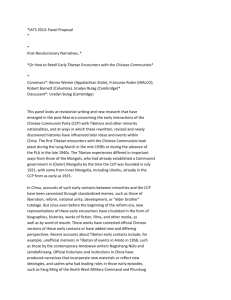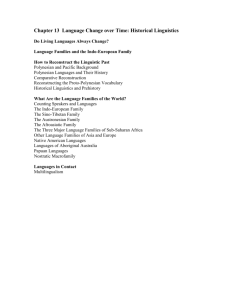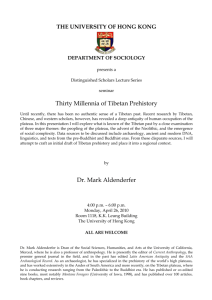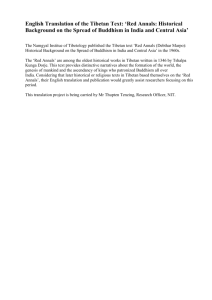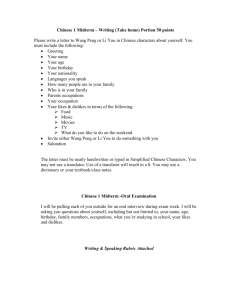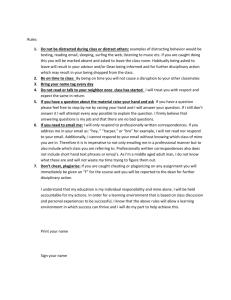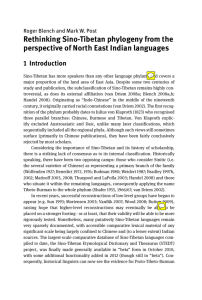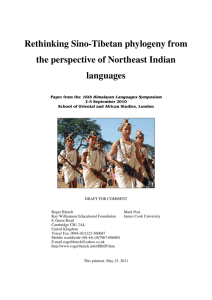On Initial Correspondences of Sino-Tibetan
advertisement
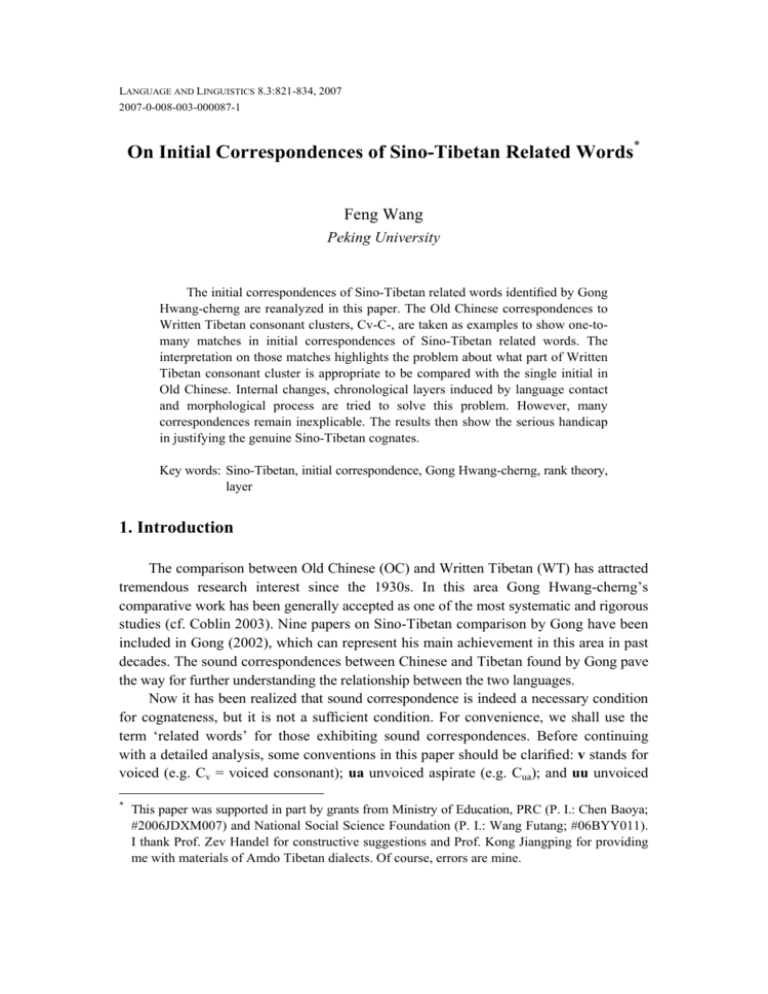
LANGUAGE AND LINGUISTICS 8.3:821-834, 2007 2007-0-008-003-000087-1 On Initial Correspondences of Sino-Tibetan Related Words* Feng Wang Peking University The initial correspondences of Sino-Tibetan related words identified by Gong Hwang-cherng are reanalyzed in this paper. The Old Chinese correspondences to Written Tibetan consonant clusters, Cv-C-, are taken as examples to show one-tomany matches in initial correspondences of Sino-Tibetan related words. The interpretation on those matches highlights the problem about what part of Written Tibetan consonant cluster is appropriate to be compared with the single initial in Old Chinese. Internal changes, chronological layers induced by language contact and morphological process are tried to solve this problem. However, many correspondences remain inexplicable. The results then show the serious handicap in justifying the genuine Sino-Tibetan cognates. Key words: Sino-Tibetan, initial correspondence, Gong Hwang-cherng, rank theory, layer 1. Introduction The comparison between Old Chinese (OC) and Written Tibetan (WT) has attracted tremendous research interest since the 1930s. In this area Gong Hwang-cherng’s comparative work has been generally accepted as one of the most systematic and rigorous studies (cf. Coblin 2003). Nine papers on Sino-Tibetan comparison by Gong have been included in Gong (2002), which can represent his main achievement in this area in past decades. The sound correspondences between Chinese and Tibetan found by Gong pave the way for further understanding the relationship between the two languages. Now it has been realized that sound correspondence is indeed a necessary condition for cognateness, but it is not a sufficient condition. For convenience, we shall use the term ‘related words’ for those exhibiting sound correspondences. Before continuing with a detailed analysis, some conventions in this paper should be clarified: v stands for voiced (e.g. Cv = voiced consonant); ua unvoiced aspirate (e.g. Cua); and uu unvoiced * This paper was supported in part by grants from Ministry of Education, PRC (P. I.: Chen Baoya; #2006JDXM007) and National Social Science Foundation (P. I.: Wang Futang; #06BYY011). I thank Prof. Zev Handel for constructive suggestions and Prof. Kong Jiangping for providing me with materials of Amdo Tibetan dialects. Of course, errors are mine. Feng Wang unaspirated (e.g. Cuu); <> corresponds to; > change into; and [ ] square brackets for meaning notations. Checking the Sino-Tibetan (ST) related words found by Gong, the rules for final correspondences generally involve one-to-one matches, or can be explained by certain sound conditions. However, the correspondences of initials between Chinese and Tibetan are much more complex. Based on Gong’s (1995) ST lists, in some corresponding syllables, WT has consonant clusters while OC has only single initials. For instance, WT gnyis [two] <> OC 二 *njidh; WT rku [to steal, to rob] <> OC 寇 *kugh. The question is how to explain the formation of such correspondences? There are at least two possibilities: 1. Single initials in OC are derived from consonant clusters such as those in WT, that is, **gn- > OC *n-; **rk- > OC *k-; 2. Prefixes in WT are acquired after the split of Tibetan from OC; that is, **n- > WT *gn-; **k- > WT *rk-. Then the question is to explain how the prefix is acquired in Tibetan. Focusing on WT Cv-C- <> OC C- in Gong (1995)’s ST lists, it is expected to have some further understanding of the relationship between the two languages. It is well-known that WT employs complex inflectional systems. A root may have several morphological variants. In Gong (1995)’s ST lists, sometimes several forms of WT are listed to correspond to a form in Chinese. For example, OC 披 *phrjal [divide] <> WT ’bral [to be separated, parted from], ’phral [to separate, to part], ral [rent, cleft, torn]. When defining related words between two languages, the semantic match is argued to be rigorous. In other words, the semantic connection of related words should be demonstrated either in literal evidence or universals of semantic changes (cf. Chen 1999, F. Wang 2006). According to this principle, the form “’phral [to separate, to part]” in WT holds priority as the counterpart to OC. For some correspondences like OC 粉 *pjnx [flour] <> WT dbur [to smooth], OC 井 *tsji [a well] <> WT rdzi [pond], OC 肝 *kan [liver] <> WT mkhal [kidney, reins], the semantic connection would be not accepted at the present stage. All the correspondences in Gong (1995) will go through this procedure and those fitting the requirement will be data for further investigation in this paper. 2. Single initials in OC are derived from consonant clusters (Cv-C-) in WT? At first, if we hypothesize that the OC single initials are derived from such consonantal clusters (Cv-C-) as those in WT, we may deduce that the pre-initial, Cv-, disappear in OC. The loss of the pre-initial causes different changes of the following initial. In order to find the change patterns, we divide the cluster, Cv-C-, into three categories: (I) Cv-Cv-; (II) Cv-Cuu-; (III) Cv-Cua-. 822 On Initial Correspondences of Sino-Tibetan Related Words (I) Cv-CvThree patterns can be found in OC. (a) Pre-initial Cv- is simply lost without any effect on the root initial. After loss of the pre-initial, there is (b) unaspirated devoicing of the root initial or (c) aspirated devoicing of the root initial. The ST examples for the three patterns are listed, respectively. (a) OC 貧 *bjin [poor] 貔 *bjid [a wild animal, possibly some kind of panther or leopard] 銀 *jin [silver] 曩 *na [in past time] 讓 *nja [cede, yield, give way] 二 *njidh [two] 殘 *dzan [damage, hurt, remainder] 五 *ngagx [five] 夢 *mjh [dream] 霧 *mjugh [fog, mist] 耳 *njgx [ear] 偽 *wjig [false, cheat] 焚 *bjn [to burn] 渡 *dagh [to ford] 是 *djigx [this, this is, is] 住 *drjukh [to stop] 逗 *dugh [to remain, to stay] 含 *gm [hold in the mouth, put in the mouth] 荷 *gar [carry] WT dbul [poor, poverty] dbyi [lynx] dul [silver] gna-bo < *gna-bo [ancient, in old times] gna [to give, grant, concede] gnyis [two] gzan-pa [to wear out, hurt, waste] lnga [five] rma-lam [a dream] rmu-ba [fog, foggy] rna [ear] rod [to deceive, to seduce] ’bar [to burn, to blaze] ’da [to pass over] ’di [demonstr. pron. this] ’dug [to remain, to stay, to live, to be, to exist] ’dug [to remain, to stay, to live, to sit] ’gam [to put, to throw, into the mouth] ’gel, pf. bkal, fut. dgal, imp. khol [to load, to lay on a burden] 護 *gwag [to guard, protect], 扈 *gwag [to ’gogs [to prevent, to avert unfortunate stop, to check, to tend (sc. horses)] events, fatal consequences], ’gog-skyo [to guard, to protect] 緩 *gwan [slow, delay] ’gor [to tarry, linger] 惶 *gwa [fearful; agitated] ’go [to despond, be in fear] 823 Feng Wang 量 *rjang [to measure]; *rjangs [a measure] ’grang [to number, to count], grangs [number] 越 *gwjat [transgress, extend] ’grod [to go, to travel], bgrod [to walk, to go, wander] 于 *gwrjag [go to] ’gro [to walk, to go] 慚 *dzam [ashamed] ’dzem [to feel ashamed] Table 1: OC examples for a simple loss of the pre-initials in WT (b) OC 臧 *tsa [good] 四 *s (< *l) jidh [four] 波 *par [wave, surge] 九 *kjgwx [nine] 晝 *trjgwh [time of day light, day] 癉 *tanx [to disease, suffering, distress] 塚 *trjux [mound, peak] 展 *trjanx [roll over, unfold] 椓 *truk [beat, strike] 稟 *prjmx [rations, receive] 分 *pjn [divide, distribute] 干 *kan [knock against, violate] 幾 *kjdx [small, little, few, several] 蓋 *gap [to thatch, to cover], *kabh [to cover, a cover] 攫 *kwjak [seize] *knx [neck] 爭 *tsr < *rtsi [strife, quarrel] WT bza [good] bzhi < *b-lyi [four] dba [wave] dgu [nine] gdugs [mid-day, noon] ldar [to be weary, tired, faint] rdu [a small mound, hillock] rdal [to spread, to extend] rdug [to strike against] ’brim [to distribute, deal out, hand round] ’bul [to give; offering, gift, present] ’gal [to be in opposition or contradiction to, to violate] ’ga [some, a few, several] ’gebs, pf. bkab, fut. dgab [to cover] ’gog, pf. bkog, imp. khog [to take away forcibly, to snatch, tear away, to rob, plunder] ’gul [neck], mgul [neck, throat], mgur [throat, neck] ’dzi [to quarrel, contend, fight] Table 2: OC examples of loss of pre-initials in WT and unaspirated devoicing of root initials 824 On Initial Correspondences of Sino-Tibetan Related Words (c) OC 痛 *tuh [to be pained] 寢 *tsjmx [lie down to sleep] 戡 *km [to vanquish, kill] 曲 *kjuk [bend, cooked] WT gdu(s) [to feel pain, to be pained] gzim [to fall asleep, to sleep] ’gum, pf. bkum, fut. dkum, imp. kum(s) [to kill, to put to death] ’gugs [to bend, to make crooked] Table 3: OC examples of loss of pre-initials in WT and aspirated devoicing of root initials (II) Cv-CuuThere are three possibilities in the development of the root initial Cuu-: (a) no change; (b) aspiration; (c) voicing. For example: (a) OC 洒 *silx [wash] 尊 *tsn [to honour, honorable] 髀 *pjidx [femur, haunch] 攪 *krkwx [disturb] 鮮 *sjan [fresh fish, fresh meat] 算 *sanh [to count] 三 *sm [three] 滴 *tik [a drop, to drop] 睹 *tag [see] 摺 *tjp [to fold] 死 *sjidx [die, death] WT bsil [wash] btsun [respectable, noble, honorable] dpyi [hip] dkrug [to stir, agitate, to disturb] gsar [new, fresh] gshor [to count, to measure] gsum [three] gtig(s) [to fall in drops, to drop], btig [to drop, let fall in drops] lta [to look, to view] ltab [to fold or gather up] ’chi < *’syi [to die, death] Table 4: OC examples of simple loss of pre-initials in WT (b) OC 寇 *kugh [to rob, robber] 惷 *tjnx [stupid] WT rku [to steal, to rob] rtul [blunt, dull, stupid] Table 5: OC examples of loss of pre-initials in WT with added aspiration of root initials 825 Feng Wang (c) OC 饉 *grjns [famine] 字 *dzjs [to breed, to love, fondle] 藏 *dzang [conceal, to store] 談 *dam [to speak] 鈍 *dnh [dull] 掘 *gwjt [to dig out] WT bkren [poor, hungry] btsa [to bear, to bring forth] gsang [to conceal] gtam [talk, discourse, speech] rtul [blunt, dull, stupid] rkod, rko [to dig, dig out, to hoe] Table 6: OC examples of loss of pre-initials in WT with voicing of root initials (III) Cv-Cua.Two possibilities for the root initials can be observed: (a) no change; (b) deaspiration. For example: (a) OC 披 *phrjar [divide] 餐 *tshan [to eat; food, meal] 璨粲 *tshanh [bright, splendid] WT ’phral [to separate, to part] mtshal [to eat; food] mtshar [fair, fine, beautiful, bright, shining] Table 7: OC examples of simple loss of pre-initials in WT (b) OC 奮 *pjn [spread the wing, fly up], 飛 *pjd [fly] 板版 *pranx [a plank, board] 分 *pjn [divide, distribute] 歸 *kwjd [return] 竿 *kan [bamboo pole, rod] 篤 *tkw [firm, solid, thick] 織 *tjk [weave stuff made of] 滴 *tik [a drop, to drop] 梗 *krax [strong] 鐫 *tsjuan [chisel, sharp pointed] WT ’phur [to fly] ’phar < *’phrar [board, flat board] ’phul [to give] ’khor < OT ’khord < *hkors [circle, to turn around, to return, to come home] ’khar [staff], mkhar [staff, stick] ’thug, mthug [thick, thickness, dense] ’thag [to weave] ’thig [to drop, to fall in drops] mkhra, khra [hard, solid, firm] mtshon [any pointed or cutting instrument] Table 8: OC examples of loss of pre-initials in WT and de-aspiration of root initials 826 On Initial Correspondences of Sino-Tibetan Related Words Considering the influences mentioned in Li (1933), prefixes s-, b-, d-, and g- cause aspirated root initials to change into unaspirated, and then they never appear before aspirated consonants, while prefixes a-chung (transcribed ’-) and m-, allow the aspiration of the following root initial. This may explain the rarity of such a combination as Cv-Cua- in WT. If we observe the change of ’-Cua- and m-Cua- in Tibetan dialects, we may find that for ’-Cua- de-aspiration of the root initial can occur, while it never occurs for m-Cua-, as seen in the examples given in Jiang (2002:233-234). (The de-aspirated examples are marked in boldface). Gloss fly thick shot (arrow) gong rotate drink thorn thumb kidney armpit liver lake WT ’pur ’tug ’pen ’kar ’kor ’tu ’tser mte mkal mtan mtin mtso Lhasa pir55 tu:55 paŋ52 ka:55 kor55 tu55 tse55 te55 k55 t53 tĩ55 tso55 Xia’erba Ba’erti Batang Dege pi:r51 piu pi53 tu55 tuk tu55 tu53 pen55 te:r51 ka55 ka53 kor ba ko55 tu:51 tu55 tu53 tse:r51 ts13 te51 te te55 ka:i51 ke55 t tĩ13 ten55 tĩ:51 tin tĩ55 tin55 tso53 tso ts53 Xiahe pr t hen kar kor to tser te ka tan t tso Alike tok npen nkar tser mte mka ntan ntn mtso Table 9: The change of ’-Cua- and m-Cua- in Tibetan dialects Based on data in Hua (2002), this distinction can be obtained in the change from WT to Hongyuan Tibetan, which is said to preserve most of the prefixes. Five out of a total of 47 ’-Cua- examples lost aspiration in Hongyuan Tibetan. For example: Gloss curl up sew sell (rice) cooked shave, scrape WT ’kum/skum ’tsem ’tso/btso ’tsos ’thog Hongyuan Tibetan km tsem/ptsem tso/ptso tshu ptok Table 10: The change of ’-Cua- in Hongyuan Tibetan 827 Feng Wang However, none of the total of 31 m-Cua- examples lost aspiration.1 The interpretation of a-chung is still a debate (see Handel 2004:614-616 for a concise review). Some scholars argue that a-chung should be some sort of nasal (Li 1933, Róna-Tas 1966, Beyer 1992), while others propose a glottal stop for a-chung (Benedict 1972:123, Matisoff 1970, Pulleyblank 2000). Whatever interpretation may stand, here I would like to emphasize a difference between a-chung and prefix m-, that is, as shown above, a-chung has a weak function to de-aspirate the following root initial, but the m- prefix does not. If this observation is right, the tentative ST related words, OC 梗 *krax <> WT mkra [hard, solid, firm] is probably dubious because the deaspiration of root initial occurs even following prefix m-. Therefore, according to this observation, the two patterns, III(a) and III(b), can be explained by internal sound change. That is, m-Cua- only produces III(a), while ’-Cua- can result in either of them, but how it is conditioned remains unclear. 3. Layers in Sino-Tibetan related words? According to the analyses in §2, some one-to-many matches are attested, for instance, I(a), I(b) and I(c) suggests the one-to-three match between WT and OC; II(a), II(b) and II(c) shows another one-to-three match between WT and OC. Now, the question is how to explain their formations. Taking as examples the three patterns, I(a) (WT Cv-Cv- <> OC *-Cv), I(b) (WT CvCv- <> OC *-Cuu.), and I(c) (WT Cv-Cv- <> OC *-Cua.), it is unlikely that these three patterns are due to internal sound changes. In Tibetan dialects, after the loss of voiced pre-initials, the root initials either remain voiced or devoiced, but not both (cf. Jiang 2002:222). And we have not yet found that the three different patterns are conditioned by some circumstances. Could one of the three patterns be due to a morphological process in OC? For instance, the words of I(b) (WT Cv-Cv- <> OC *-Cuu.) pattern are derived from earlier roots with voiced initials due to some devoicing morphological modification in Chinese. Or, the words of I(a) (WT Cv-Cv- <> OC *-Cv) pattern are derived from earlier roots with unvoiced initials due to some voicing morphological modification in Chinese. In fact, some similar processes are proposed for some initial alternation in Chinese, i.e. intransitive voicing of prefix N- (Sagart 2003:757-768). In the following examples,2 the intransitives are argued to be secondary: 1 2 One example may show the voicing function of m-, i.e. mtsho (WT) > mdz e r mo (Hongyuan Tibetan) [loops and whorls on a finger]. The reconstruction in the three pairs follows Baxter’s (1992) Middle Chinese system. 828 On Initial Correspondences of Sino-Tibetan Related Words 別 pjet (III) [to separate, distinguish]: 別 bjet (III) [to take leave] 敗 paejH [to defeat]: 敗 baejH [to be defeated] 張 trjang [to stretch]: 長 drjang [long] Among Chinese words in I(a), I(b), or I(c) pattern, to my knowledge there is no such pair available. Language contact can provide a possible explanation for this one-to-three match (cf. Chen 2003). That means that I(a) (WT Cv-Cv- <> OC *-Cv), I(b) (WT Cv-Cv- <> OC *-Cuu.), and I(c) (WT Cv-Cv- <> OC *-Cua.) indicate different layers of the SinoTibetan related words. According to rank theory (Chen 1996, Wang & Wang 2004), for a certain layer, if the percentage of related words in high rank (Swadesh 100 basic words) is higher than that in low rank, this layer is very likely to be inherited; otherwise, the layer may be borrowed. Sometimes the limited number of high/low rank may not be significant enough to tell the status, and we can use another ranking, that is, kernel rank (high rank + low rank) vs. non-kernel rank (cf. Chen 1996, H. Wang 2006). In the I(a) pattern, there are six kernel rank words (焚 [burn], 是 [this], 耳 [ear], 二 [two], 霧 [fog], 五 [five]). In the I(b) pattern, there are five ( [neck], 幾 [few], 晝 [day], 臧 [good], 四 [four]). In the I(c) pattern, there is one (寢 [sleep]). The distribution is shown as follows: kernel rank non-kernel rank Trend of rank I(a) 6/12 = 50% 20/35 = 57% Rising I(b) 5/12 = 42% 12/35 = 34% Falling I(c) 1/12 = 8% 3/35 = 9% Rising Therefore, the layer I(b) is possible to be inherited from Proto-Sino-Tibetan, while layer I(a) and I(c) to be borrowed into Chinese. Similarly, we can list the distribution of II(a), II(b), and II(c) between ranks as below: kernel rank non-kernel rank Trend of rank II(a) 5/7 = 71% 5/11 = 45% Falling II(b) 0/7 = 0% 2/11 = 18% Rising II(c) 2/7 = 29% 4/11 = 36% Rising This may suggest that II(a) is inherited from Proto-Sino-Tibetan, while II(b) and II(c) are borrowed into Chinese. 829 Feng Wang However, the above analysis has to meet a problem about numerals.3 According to the tentative identification, ‘two’ and ‘five’ are borrowed while ‘four’ and ‘nine’ are inherited. This would be very unlikely since higher numerals are more easily borrowed than the lower according to general observations. Therefore, the interpretation in terms of historical stratification fails to explain the formation of the two sets of one-to-many matches (I(a), I(b), I(c); II(a), II(b), II(c)). In summary, neither morphological process nor historical stratification can provide a sound account. This leads us to think that some examples in the two sets may be not ‘related words’ at all. Looking into ‘nine’ as the example: OC 九 *kjgwx [nine] <> WT dgu. The exact initial match, k <> dg, is not supported by any parallel example in the list. In the rigorous definition of sound correspondence, such a match should not be counted. Sadly, regardless of such problems, the numerals as Sino-Tibetan cognates have been taken for granted for a long time. 4. The prefix in WT is acquired independently? If we suppose that some prefixes in WT are acquired independently, they must be used for some reason. A sound change like *n- > *gn- is very unlikely. Even so, another problem may arise, such as why this change does not spread to other words with n-initials. Therefore, most likely, the acquisition of these prefixes in WT is due to their morphological function. Naturally, this will require two tasks: (1) The morphological function should be detected; (2) The semantic equivalence between Tibetan and OC should be justified after counting in the morphological function of those prefixes. For examples of ST-related words with exact semantic matches, this interpretation may not work. Pertinent examples will be those with different meanings between Chinese and Tibetan, and their difference can be accounted for by the prefix in WT. For instance: OC 披 *phrjal [divide] 順 *djnh [obey, submissive] 曲 *kjuk [bend, cooked] 援 *gwjan [to succour] 洽 *grp [unite, accomplish] WT ’bral [to be separated, parted from] ’dul [to tame, to subdue, conquer] ’gugs [to bend, to make crooked] ’grol, pf. grol [to become free, to be liberated, released from] ’grub [to be finished, accomplished] Table 11: Examples of causative prefix a-chung in Written Tibetan 3 I thank the anonymous reviewer for pointing this out to me. 830 On Initial Correspondences of Sino-Tibetan Related Words The above examples seem to show the causative function of a-chung and its voicing function in WT. Therefore, these sets of ST related words are comparable in semantics. However, some examples that follow might be better left aside until a morphological explanation or other interpretation is available. OC 顫 *tjan [shivering, trembling] 絡 *rak [silk thread, cord, bridle] 慈 *dzjg [affectionate, loving] 鑚 *tsuan [to bore, perforate, penetrate] WT ’dar [to tremble, shudder, shiver, quake] ’grags [to bind] mdza [to love, as friends or kinsmen do] mtshon [any pointed or cutting instrument] Table 12: Examples for unknown function of a-chung or m- prefix in WT Of course, it is possible to propose ad hoc morphological functions of a-chung or m- prefixes in WT in order to explain any semantic difference between OC and WT in the above examples. However, to make the comparison seriously will require parallel examples, either among candidates of Sino-Tibetan related words, or in WT. 5. Conclusion In the Sino-Tibetan area, more and more tentatively related words are proposed. Now may be a good time to pay much more attention to examining the correspondences of words related both phonetically and semantically. In the preface of his monograph, Gong Hwang-cherng stated: 漢藏同源詞的認定,是以原始漢藏語的存在及從原始漢藏語到各個別語 言有規律的演進為前提。同源詞的認定應該建立在整個音韻系統的對應 上,而對應關係必須能合理解釋漢語與藏緬語從原始漢藏語演變的過 程。這樣的基本認識,似乎在一些著作中全然缺乏。我們要找真正的同 源詞,必須不斷地檢討,不斷地改進,正如羅杰瑞所說,我們必須從可 靠的同源詞中去發現正確的對應關係,再從正確的對應關係中去發現更 多的同源詞。(Gong 2002:iii) Following this tack, this paper examined the initial correspondences of Sino-Tibetan related words in terms of rigorous requirements. Thanks to Gong’s substantial work on Sino-Tibetan-related work, this paper can have some observation on the formation of initial correspondences between Tibetan and Chinese. The formation of these correspondences may involve internal sound change (see III of §2) or a morphological process (§4). 831 Feng Wang Some correspondences between Chinese and Tibetan are involve stratification. Given the fact that Tibetans and Chinese came into contact thousands of years ago, it may be unrealistic to regard all related words between Tibetan and Chinese as Sino-Tibetan cognates (Bodman 1980). Moreover, the establishment of many initial correspondences is still in need of parallel examples, morphological explanation, or stratification. We have to realize that this is a handicap in justifying genuine Sino-Tibetan cognates. References Baxter, William H. 1992. A Handbook of Old Chinese Phonology. Berlin & New York: Mouton de Gruyter. Benedict, Paul K. 1972. Sino-Tibetan: A Conspectus. Cambridge: Cambridge University Press. Beyer, Stephan V. 1992. The Classical Tibetan Language. Albany: State University of New York Press. Bodman, Nicholas. 1980. Proto-Chinese and Sino-Tibetan: data towards establishing the nature of the relationship. Contributions to Historical Linguistics: Issues and Materials, ed. by Frans van Coetsem and Linda Waugh, 34-199. Leiden: E. J. Brill. Chen, Baoya. 1996. Lun Yuyan Jiechu yu Yuyan Lianmeng [Language Contact and Language Union]. Beijing: Yuwen Chubanshe. Chen, Baoya. 1999. Ershi Shiji Zhongguo Yuyanxue Fangfalun [Methodologies of Chinese Linguistics in the 20th Century]. Jinan: Shandong Jiaoyu Chubanshe. Chen, Baoya. 2003. On method of stratifying correspondences. Paper presented at the Workshop on “Stratification of Loan Words”. Hong Kong: City University of Hong Kong. Coblin, Weldon South. 2003. A recent contribution to Sino-Tibetan linguistics. Language and Linguistics 4.4:887-902. Gong, Hwang-cherng. 1995. The system of finals in Proto-Sino-Tibetan. The Ancestry of the Chinese Language, ed. by William S-Y. Wang, 41-92. Berkeley: Project on Linguistic Analysis. Gong, Hwang-cherng. 2002. Collected Papers on Sino-Tibetan Linguistics. Taipei: Institute of Linguistics, Academia Sinica. Handel, Zev. 2004. Methodological considerations in the application of Tibeto-Burman comparison. Studies on Sino-Tibetan Languages: Papers in Honor of Professor Hwang-cherng Gong on His Seventieth Birthday, ed. by Ying-chin Lin et al., 603620. Taipei: Institute of Linguistics, Academia Sinica. Hua, Kan. 2002. Zangyu Anduo Fangyan Cihui [A Lexicon of Amdo Tibetan Dialects]. 832 On Initial Correspondences of Sino-Tibetan Related Words Lanzhou: Gansu Minzu Chubanshe. Jiang, Di. 2002. Zangyu Yuyinshi Yanjiu [Studies on the History of Tibetan Phonology]. Beijing: Minzu Chubanshe. Li, Fang-kuei. 1933. Certain phonetic influences of the Tibetan prefixes upon the root initials. Bulletin of the Institute of History and Philology, Academia Sinica 4.2: 135-157. Matisoff, James A. 1970. Glottal dissimulation and the Lahu high-rising tone: a tonogenetic case study. Journal of the American Oriental Society 90.1:13-44. Pulleyblank, Edwin G. 2000. Morphology in Old Chinese. Journal of Chinese Linguistics 28.1:26-51. Róna-Tas, András. 1966. Tibeto-Mongolica: The Tibetan Loanwords of Monguor and the Development of the Archaic Tibetan Dialects. The Hague: Mouton. Sagart, Laurent. 2003. Sources of Middle Chinese manner types: Old Chinese prenasalized initials in Hmong-Mien and Sino-Tibetan perspective. Language and Linguistics 4.4:757-768. Wang, Feng. 2006. Comparison of Languages in Contact: The Distillation Method and the Case of Bai. Language and Linguistics Monograph Series B: Frontiers in Linguistics III. Taipei: Institute of Linguistics, Academia Sinica. Wang, Feng, and William S-Y. Wang. 2004. Basic words and language evolution. Language and Linguistics 5.3:643-662. Wang, Hongjun. 2006. Beijinghua qingru guidiao de cengci yu jiequxian pandingfa [The tone strata of Pekingese corresponding to MC qingru and the rank contour method]. Yuyanxue Luncong 33:223-245. Beijing: Commercial Press. [Received 10 July 2006; revised 22 June 2007; accepted 29 June 2007] Department of Chinese Language & Literature Peking University Beijing 100087, China wfwf@pku.edu.cn 833 Feng Wang 漢藏語關係詞聲母對應之檢討 汪 鋒 北京大學 本文借重龔煌城先生識別的漢藏關係詞來分析漢藏之間的聲母對應,主 要考察了上古漢語與藏文複輔音聲母 Cv-C- 之間的關係,發現漢藏關係詞中 反映出的一對多現象,而對這些現象的不同解釋說明了一個漢藏比較中亟需 解決的問題,即,應該以藏語複輔音的哪一成分來匹配上古漢語中的單一聲 母?內部演變、接觸造成的時間層次或者構詞變化在文中逐一試用來解決其 中的矛盾。但是,仍然有相當多的“漢藏關係詞"之間的語音對應關係不能 得到合理解釋。結果說明,當前的漢藏關係詞認定在語音對應上的基礎性研 究亟待加強。 關鍵詞:漢藏,聲母對應,龔煌城,詞階法,層次 834

